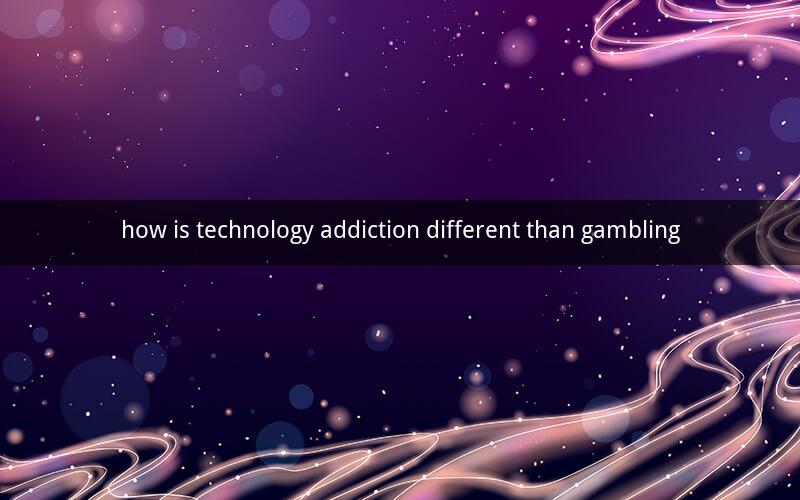
Table of Contents
1. Understanding Technology Addiction
2. The Nature of Gambling Addiction
3. Psychological and Physical Symptoms
4. The Impact on Social Relationships
5. Treatment and Prevention Measures
6. Conclusion
---
1. Understanding Technology Addiction
Technology addiction, often referred to as digital addiction or screen addiction, is a condition where individuals excessively engage with digital devices or online platforms, leading to negative consequences in their daily lives. This addiction can manifest in various forms, including social media, video games, online shopping, and other online activities.
The primary difference between technology addiction and gambling addiction lies in the nature of the behavior. While both involve excessive engagement with digital activities, technology addiction is not necessarily centered around gambling or betting.
2. The Nature of Gambling Addiction
Gambling addiction, on the other hand, is a behavioral addiction characterized by an inability to control or stop gambling despite negative consequences. This addiction often involves placing bets on various forms of gambling, such as sports, lottery, casino games, or online betting.
Gambling addiction is primarily driven by the thrill of winning and the desire to recoup losses, which can lead to significant financial, psychological, and social problems.
3. Psychological and Physical Symptoms
Both technology addiction and gambling addiction share similar psychological and physical symptoms. These include:
- Loss of control over the behavior
- Preoccupation with the activity
- Inability to stop or reduce the behavior despite negative consequences
- Withdrawal symptoms when trying to stop
- Increased tolerance, requiring more of the behavior to achieve the same effect
- Neglect of other important aspects of life, such as work, relationships, and self-care
Physical symptoms may include eye strain, headaches, and poor sleep quality, which are common in both technology and gambling addictions.
4. The Impact on Social Relationships
Both technology addiction and gambling addiction can significantly impact social relationships. Individuals with these addictions may become isolated, neglect their relationships, and experience communication difficulties. They may also struggle with trust issues and financial problems, which can strain relationships with family, friends, and partners.
5. Treatment and Prevention Measures
Treatment for technology addiction and gambling addiction typically involves a combination of therapy, support groups, and lifestyle changes. Cognitive-behavioral therapy (CBT) is often used to help individuals develop healthier coping mechanisms and address underlying issues contributing to their addiction.
Prevention measures include:
- Setting boundaries on technology use
- Engaging in healthy activities to reduce the urge to gamble or use technology excessively
- Seeking support from friends, family, or professionals
- Educating oneself about the risks of addiction
6. Conclusion
While technology addiction and gambling addiction share some similarities, they also have distinct characteristics. Understanding the differences between these addictions can help individuals recognize the signs of addiction and seek appropriate treatment and support.
---
Questions and Answers
1. Q: What are the primary differences between technology addiction and gambling addiction?
A: The primary difference lies in the nature of the behavior. Technology addiction involves excessive engagement with digital devices or online platforms, while gambling addiction is centered around placing bets on various forms of gambling.
2. Q: Can technology addiction lead to financial problems?
A: Yes, technology addiction can lead to financial problems, particularly if it involves online shopping or spending excessive amounts of money on digital content or services.
3. Q: Are there any physical symptoms associated with gambling addiction?
A: Yes, physical symptoms of gambling addiction may include headaches, eye strain, and poor sleep quality.
4. Q: How can one recognize the signs of technology addiction?
A: Signs of technology addiction include loss of control over the behavior, preoccupation with the activity, and neglect of other important aspects of life.
5. Q: What are some effective treatment options for gambling addiction?
A: Effective treatment options for gambling addiction include cognitive-behavioral therapy (CBT), support groups, and lifestyle changes.
6. Q: Can technology addiction lead to social isolation?
A: Yes, technology addiction can lead to social isolation, as individuals may neglect their relationships and become more focused on their digital activities.
7. Q: Are there any common risk factors for both technology addiction and gambling addiction?
A: Common risk factors for both technology addiction and gambling addiction include impulsivity, a history of trauma, and a lack of social support.
8. Q: Can technology addiction be prevented?
A: Yes, technology addiction can be prevented by setting boundaries on technology use, engaging in healthy activities, and seeking support from friends, family, or professionals.
9. Q: Are there any similarities between technology addiction and gambling addiction in terms of psychological symptoms?
A: Yes, both technology addiction and gambling addiction can lead to similar psychological symptoms, such as loss of control, preoccupation, and neglect of other important aspects of life.
10. Q: How can one differentiate between a healthy interest in technology and technology addiction?
A: Differentiating between a healthy interest in technology and technology addiction involves assessing the impact of the behavior on daily life, relationships, and overall well-being.